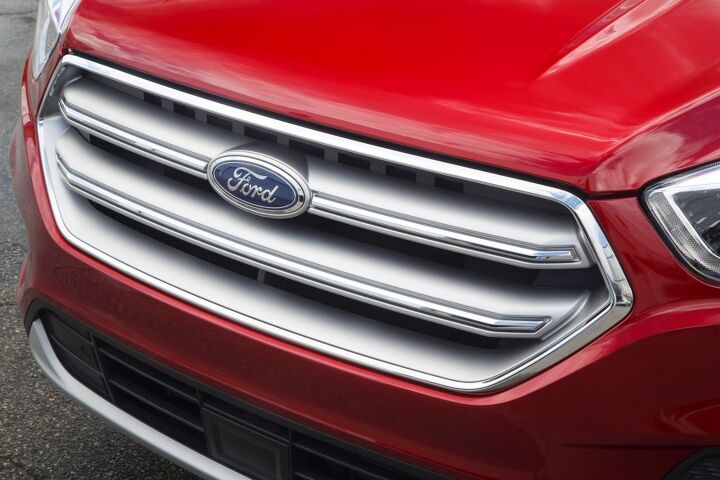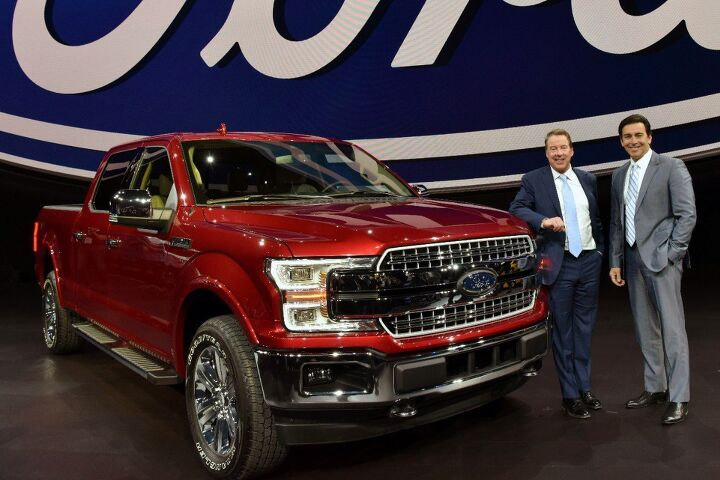#JimHackett
Ford CEO Outlines New Vehicle Development Plan, Shifts Investments, Trims Fat (and Models)
After much speculation, Ford CEO Jim Hackett has finally outlined where his company’s dollars will be spent in the foreseeable future. Hackett spent his summer performing what Ford called a “four-month deep dive” into the company’s strategy and business operations to see what changes needed to be made. His conclusions? This may surprise a few readers, but Ford will continue building and selling automobiles.
Alright, that isn’t a bombshell, but the brand is trying to frame itself as the Ford you’ve always trusted while also letting everyone know it’s still a “mobility company” with its eyes fixed on tomorrow. Without the public relations veneer, that plan translates into a reduced number of production models and trims, more money for electrification R&D, less for internal combustion engines, and a significant reduction in material costs.
Hackett’s address also served to reassure the nervous shareholders who ousted his predecessor, Mark Fields. Ford’s stock declined more than 30 percent during Fields’ tenure and many complained that his vision of transitioning from a traditional automaker to a Silicon Valley look-alike was partly to blame. Hackett did everything in his power to ease those fears.
“We’re going to be in the vehicle business moving both people and goods. Some myth about not being in the car business is gone,” Hackett told Wall Street.
Ford's CEO Might Execute Lower-margin Vehicles to Boost Profits
Ford’s new CEO, Jim Hackett, has been milling around the company trying to get a sense of what the automaker needs to thrive in today’s car market. Conducting a summer-long assessment of the company’s current status and action points, Hackett is setting himself up with a greater understanding of where Ford stands in order to share his vision of the automaker’s future with investors in early October.
However, we already have some sense of what that future entails. Hackett has already spoken with leadership from the United Auto Workers, easing union fears that he might try to clean house and cut jobs. But his reassurance that there probably won’t be massive layoffs under his leadership doesn’t guarantee low-margin automobiles won’t be at risk.
This isn’t entirely down to Hackett’s management style, either. Investors were becoming annoyed with former CEO Mark Fields’ lofty long-term strategy, which featured fewer near-term goals aimed at bolstering profitability. Some analysts expect Hackett to end production of models that aren’t big earners — which includes just about everything that isn’t an SUV, crossover, or pickup truck.
Ford CEO Shares Vision With UAW Before Wall Street Gets a Look at the Goods
Prior to outlining Ford Motor Company’s new strategy to financial analysts and corporate investors, CEO Jim Hackett wants to check-in with leadership from the United Automobile Workers. Hackett has been undertaking a summer-long assessment of the company’s current status and action points — established during Mark Fields’ executive tenure — with a mind to reevaluate the status quo.
However, before he announces his new vision for the company to Wall Street, Hackett is giving the UAW a peek. Jimmy Settles, the head of the union’s Ford department, called the move an important signal that the current boss is interested in putting workers first and starting things off on the right foot.
Ford's Autonomous Driving Effort Doesn't End at Pizza Delivery
Earlier this week, we griped about Ford Motor Company’s market research into the validity of self-driving pizza delivery vehicles. Thankfully, that’s not the sole avenue the automaker is exploring. Since abandoning Uber Technologies’ self-driving program in April, Ford’s new vice president of autonomous vehicles and electrification, Sherif Marakby, has spent the summer seeking partners that might want to put autonomous vehicles on the road in the near future.
Meanwhile, Ford chief executive Jim Hackett, who took over in May, is conducting a review of the automaker’s overall strategy, including the heavy investments made into electric and self-driving vehicles that took place under former CEO Mark Fields. While it’s unknown how viable he’ll deem every aspect of company’s Fieldsian mobility plan, early assessments hint he’ll leave Marakby plenty to work with.
Ford CEO Sees a Future for Hands-on Driving, but a New Patent Shows the Company Hedging Its Bets
If you believe certain segments of the media, we’ll soon be able to avoid the drudgery of turning a steering wheel, pressing and releasing pedals, and — gasp! — shifting gears.
The inevitable onset of self-driving vehicles, tech aficionados and urbanists tell us, will bring traffic fatalities down to zero, somehow remove all congestion from the road, and turn our lives into a never-ending sojourn of blissful tranquility. Never again will you take that aimless and unprogrammed late-night drive, just for the hell of it. Never again will you bother with buying and owning a car. Automakers will simply turn their driverless cars loose, emptying driveways while filling streets with hands-off ride-sharing pods.
Not so fast, says Ford’s newly minted CEO.
Just Make a Decision Already: Ford CEO Wants Automaker to Pick Up the Pace
While he’s only been in the big chair for little over a month, Ford Motor Company CEO Jim Hackett has already pinned down a serious problem in need of immediate change. Decision making. Or, more specifically, the need to get the lead out when rapidly changing market trends threaten company profit.
The former chairman of Ford Smart Mobility LLC, who replaced an ousted Mark Fields in late May, was brought in to guide the Blue Oval through a “transformative period” in the industry. One way he might do this is to borrow an idea from the NBA.
Bill Ford to Accept Shareholder Outrage in Place of Ex-CEO Mark Fields
Ford’s new CEO, Jim Hackett, will be able to avoid some of the shareholder wrath his predecessor assumed. With Mark Fields gone, Bill Ford has taken it upon himself to keep the dream alive and promote the company’s vision of the future while its share price continues to dwindle. The executive chairman and great-grandson of the business’ founder has expanded his duties to include managing corporate communications and interacting with the government — two tasks few would envy.
Bill Ford claims that assuming the responsibilities would allow Hackett to focus on the daily operations and better familiarize himself with the automotive world, of which he has little direct experience with. That isn’t to suggest he’s not the man for the job, but Ford sees no reason to burden him with external communication duties — which we know can get ugly — as he’s settling into the new position.
What Happened To Ford's U.S. Market Share During The Mark Fields Era?
Prior to this morning’s announcement that outgoing Ford Motor Company CEO Mark Fields is “retiring,” Fields was in charge at the Blue Oval for nearly three years. Just a little more than ten quarters, to be more precise.
In eight of those quarters, Ford Motor Company U.S. market share declined, year-over-year.
Ford was not without excuse, of course. There was always market share to be taken if Ford wanted it. But an attempt to limit reliance on daily rental fleet sales, particularly with Ford’s passenger car division, did the automaker’s market share no favors. Ford’s transition from old F-150 to the new aluminum-bodied model was a major switch, too, and sales growth during the transition phase wasn’t easy to come by.
Nevertheless, Ford’s U.S. market share didn’t nosedive during the Mark Fields era. The burden on incoming CEO Jim Hackett’s shoulders won’t be the elevation of Ford Motor Company market share in the automaker’s home market.
No, it’s the price of a Ford share that matters right now.
Ford Makes It Official: Jim Hackett is the Company's New Top Boss
Ahead of a news conference at Ford’s Dearborn headquarters, the automaker has announced Jim Hackett as its new president and chief executive officer.
The news follows last night’s report of the ouster of former CEO Mark Fields by the company’s board of directors. In an official release, Ford refers to Hackett as a “transformational business leader” who will succeed the “retiring” Fields.
Before being named chairman of the newly created subsidiary Ford Smart Mobility LLC in March of 2016, Hackett, 62, served on the company’s board for three years and was a member of its Sustainability and Innovation committee. Prior to joining Ford, the executive gained accolades for his turnaround of American office furniture company Steelcase, where he spent 30 years. As interim director of athletics at the University of Michigan, Hackett lured Jim Harbaugh away from the San Francisco 49ers to serve as head football coach.
Hackett’s job won’t be an easy one. Besides guiding the company through a disruptive era of new technologies, the new CEO must reverse Ford’s flagging fortunes.
Ford to Announce Firing of CEO Mark Fields This Morning: Report
Mark Fields has reportedly been fired from his position as CEO of Ford Motor Company, to be replaced by a man he appointed as head of the automaker’s mobility subsidiary.
According to Forbes, the company will announce the appointment of Jim Hackett as CEO this morning, part of a broader shakeup of the company’s upper ranks. Hackett, former CEO of Steelcase, served on the automaker’s board for three years before being named head of Ford Smart Mobility LLC in March, 2016.
Fields, a 28-year Ford veteran who replaced Alan Mulally in mid-2014, was reportedly booted by the company’s board amid a continued decline in share values. Two weeks ago, the CEO was grilled by board members and shareholders alike over the direction he has taken the company.
























Recent Comments